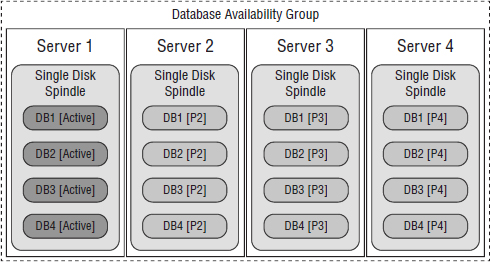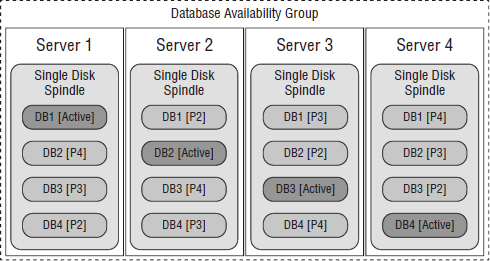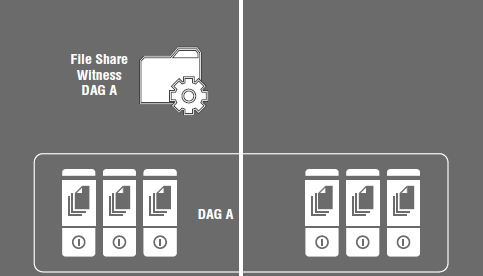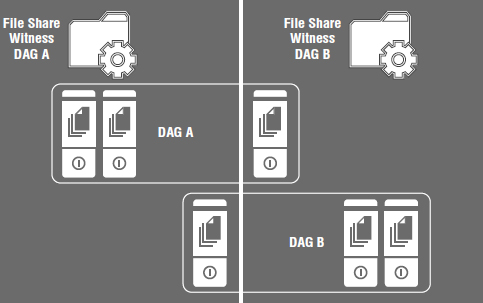3. Exchange Hybrid Deployment
Exchange Online presents its own set of SLAs, and
it is of interest to us in terms of its interactions with on-premises
Exchange. Assuming that your organization is running in Hybrid mode,
there will be three on-premises points of interaction with Exchange
Online. Specifically, these interaction points are as follows:
- Exchange CAS servers
- Directory synchronization
- Active Directory Federation Services 2.x
Each of these is not highly available by
default because each is deployed on a single server. The only possible
exception for keeping a single server may be directory synchronization,
since it is built as a no-touch software appliance by default, unless
deployed using the full-featured Forefront Identity Manager using a
highly available SQL instance.
Exchange Client Access
Servers providing Exchange Hybrid mode integration may be a subset of
the total number of Client Access Servers contained in your
organization. If more than one of these exists, they will be
load-balanced via some sort of load-balancing mechanism. Client Access
Servers facilitating Exchange Hybrid mode are responsible for the
interaction between Exchange Online and on-premises Exchange and
directly facilitate the features required, which makes the on-premises
system and Office 365 appear as a single organization. With this in
mind, you will do well to ensure that sufficient redundancy exists to
guarantee availability during a server outage, as well as during
periods of high server load.
Active Directory Federation Services (AFDS)
enable external authentication to an on-premises Active Directory by
validating credentials against Active Directory and returning a token
that is consumed by Office 365, thereby facilitating one set of Active
Directory credentials to be used against both on-premises services as
well as Office 365. ADFS servers may have a DMZ-based component (ADFS
Proxy servers) alongside the LAN-based ADFS server. ADFS Proxy servers are a version of ADFS that is specifically designed to be deployed in the DMZ,
a secure network location, disconnected from a production network via
additional layers of firewalls. Since all that these Proxy servers do
is to intercept credentials securely and pass them onto LAN-based ADFS
instances, they may not be required if an equivalent service is
available via Microsoft TMG/UAG or similar.
These types of servers are great
virtualization targets because of their light load. Depending on load,
you will require a minimum of two ADFS servers and two ADFS Proxy
servers.
Your availability concerns for Exchange Online/Hybrid mode include the following:
- Internet connectivity.
- Sufficient ADFS servers.
- Sufficient ADFS Proxy servers (if required).
- Networking (Reverse Proxy, firewall).
- Load balancer.
- Validity of certificates: A server certificate issued by a
third-party certificate provider, which should not be expired. The
certificate may be a SAN certificate or a wildcard certificate.
4. Database Availability Group Planning
Database availability group (DAG) planning
requires you to balance a number of factors. Most of these are
interdependent and require significant thought and planning.
DATABASE SIZING
The theoretical maximum database size should not
be based purely on the maximum database size supported by Exchange
2013. Large databases require longer backup/restore and reseed times,
especially when over the 1 TB mark. Databases size of 1 TB and upward
are impractical to back up, and they should only be considered if
enough database copies exist in order not to require a traditional
backup, specifically three or more copies. You need to strike a balance
between fewer nodes and larger databases versus more nodes and smaller
databases.
DATABASE COPIES
The number of database copies required in order
to meet availability targets is a relatively simple determination.
Early on, we discussed the number of disks or databases required in
order to calculate a specific availability. If we have been given a
stated availability target of 99.99 percent, then we will not be able
to achieve such a target with a single database copy. Four copies
within a datacenter is the minimum number required for a 99.99 percent
availability target. Taking into account the number of databases is
just one of the factors in our availability calculation.
In multi-datacenter scenarios, datacenter
activation is a manual step, as opposed to the automatic failover
provided by high availability. Therefore, switchover requires more time
and incurs more downtime that an automatic failover. While Exchange
2013 is able to automate a switchover event, we would argue that the
business via the administrator initiating the event should wield that
level of control, so that the state of Exchange is always known and
understood.
When the second datacenter uses RAID to
protect volumes on a single server, as opposed to individual servers
with isolated storage, this slightly increases the availability of each
individual volume and therefore slightly increases overall
availability. In the case of three or more database copies, however,
the additional gain will hardly justify the additional costs of
doubling the disk spindles (depending on the RAID model) and the
additional RAID controllers. Applying the principle of failure domains,
it may be cheaper to deploy extra servers with isolated storage, as
opposed to deploying the extra disks and RAID controller per RAID
volume required to achieve higher availability.
DATABASE AVAILABILITY GROUP NODES
The number of DAG nodes is driven not only by the
number of copies required but also by how many nodes are required in a
database availability group in order to maintain quorum. Quorum
is the number of votes required to establish if the cluster has enough
votes to stay up or to make a voting decision, such as mounting
databases. Quorum is calculated as the number of nodes/2 + 1. A
three-node cluster can therefore suffer a single failure and still
maintain quorum. Odd-numbered node sets easily maintain this
mathematical relationship; however, even-numbered node sets require the
addition of a file share witness.
FILE SHARE WITNESS LOCATION
The file share witness is an empty file
share on a nominated server that acts as an extra vote to establish
cluster quorum. Whichever datacenter in which the file share witness is
located may be considered the primary datacenter. In Exchange 2013, the
file share witness may be located in a third datacenter from the
primary and secondary location, thereby eliminating the risk of split brain,
which is a condition that occurs when two datacenters become active for
the same database copy. Changes are now written to different instances
of the same database, which requires considerable effort to undo should
the WAN link between the primary and secondary datacentre break. This
change, while not recommended, is now supported in Exchange 2013, and
it is the first version of Exchange to support the separation of the
file share witness into a third datacenter.
DATABASE DISTRIBUTION
The distribution of databases on database
availability group nodes has a direct impact on performance and
availability. In order to demonstrate this concept, consider a
four-node DAG with four database copies and with all databases active
on Server 1, as shown in Figure 4.
FIGURE 4 Uneven database distribution

Server 1 will serve all of the required
client interactions, while Servers 2, 3, and 4 remain idle, with the
exception of logging replay activity. Assuming Server 1 fails, all
active copies fail with the server and, depending on the health of the
remaining copies, may all activate on Server 2. This is a highly
inefficient distribution structure.
Figure 5
shows how databases are distributed in a manner such that client and
server load is balanced and failure domains are minimized (assuming the
storage is not shared). Note that this symmetry is precalculated on a
current version of the Exchange calculator.
FIGURE 5 Balanced database distribution

DETERMINING QUORUM AND DAC
If you have
DAC mode enabled on your DAG and a WAN failure occurs, both datacenters
will dismount databases in order to prevent split brain. By design, DAC
mode may be the cause of an outage if it is not implemented correctly.
If properly implemented, however, it will act as an extra layer of
quorum against split brain.
If WAN links are unreliable, and your DAG appears similar to Figure 6, consider planning your DAGs without DAC mode, as per Figure 7.
FIGURE 6 Single DAG with DAC mode

DAGs may be split into two or more DAGs
with either datacenter maintaining quorum if a WAN failure occurs,
similar to what appears in Figure 7.
FIGURE 7 Multiple DAGs without DAC mode
